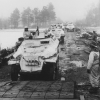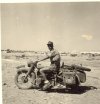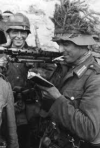What a behemoth.
I understand that radiator on their side was their Achilles heel.
Reading up on the B1's during the Battle of france it seems that tactics and especially logistics had a lot to do with the demise of the French tank divisions.
For more information - more than yu would probably want to know - and a good description of how the 4 armored divisions fared in the may of 1940 check out this website:

 tanks-encyclopedia.com
tanks-encyclopedia.com
From "1ère DcR: Annihilation at Flavion"
"During the day of the 15th, it found itself with no support whatsoever from either infantry, artillery, or aviation – while opposing German tanks were supported by all three. German vehicles also vastly outnumbered the French. In one instance, a B1 Bis, n°415 “Quincyâ€, reported being engaged by about 15 Panzer III and IVs, the crew escaping miraculously despite a broken radiator thanks to a slope which allowed the vehicle to escape for a moment, long enough for the crew to be rescued by another B1 Bis, n°282 “Tunisâ€."
"The B1 Bis in the campaign of France: An analysis
The B1 Bis’ performance during the short campaign of France is a complex subject.
When seeing the vehicle’s combat records, one can hardly claim the B1 Bis was without faults. No tanks in service in the army of one of the belligerents, save perhaps for the British A12 Matilda, could have been able of feats performed by some individual B1 Bis, such as resisting a large number of hits while knocking out a quantity of enemy tanks in a short timespan, as the B1 Bis Eure did at Stonne. The vehicle proved to be, at times, a major headache for German troops, being typically invulnerable to German tank guns. Its firepower was considerable and varied.
At the same time though, a tank as complex, vulnerable to breakdown, and fuel-hungry as the B1 Bis could not reasonably be expected to perform well in an army with poor logistics. The situation of the campaign of France, with French logistical lines being quickly thrown into chaos by a mixture of poor organization and communications, and a very large number of refugees on the roads, meant that more often than not, a mere minor breakdown or fuel shortage would be fatal to the heavy and expensive B1 Bis. And while mighty and powerful, the very poor ergonomics of the tank, combined with the almost systematically lacking coordination with infantry and aviation, meant that B1 Bis were at times very easy targets for the German weapons that could dispose of them, occasionally Junkers Ju 87 Stukas, but much more regularly larger caliber artillery pieces, typically 88 mm anti-aircraft guns but also 105 mm field guns, which could also hope to penetrate or cause high damage to the French heavy tank. Despite its mighty armor and heavy armament, the B1 Bis ended up being no considerable obstacle to Germany’s lightning-fast invasion of France, and while French crews occasionally caused high losses to their adversaries, many of these knocked out vehicles would later be repaired by the Germans – as well as numbers of lightly damaged B1 Bis which would be pressed into service into the Wehrmacht.
It comes as no surprise that the B1 bis suffered very high losses during the campaign of France. An attempt to count the losses places them at 128 B1 Bis lost in combat, and 139 abandoned or scuttled due to breakdowns or fuel shortages. Only 21 vehicles were known to still be operational at the end of the campaign, while 79 had an unknown fate."
I understand that radiator on their side was their Achilles heel.
Reading up on the B1's during the Battle of france it seems that tactics and especially logistics had a lot to do with the demise of the French tank divisions.
For more information - more than yu would probably want to know - and a good description of how the 4 armored divisions fared in the may of 1940 check out this website:

Char B1 Bis - Tank Encyclopedia
The Char B1 Bis was a heavy tank used by the French army in 1940, famous for strong firepower and armor, but also complexity and unreliability.
 tanks-encyclopedia.com
tanks-encyclopedia.com
From "1ère DcR: Annihilation at Flavion"
"During the day of the 15th, it found itself with no support whatsoever from either infantry, artillery, or aviation – while opposing German tanks were supported by all three. German vehicles also vastly outnumbered the French. In one instance, a B1 Bis, n°415 “Quincyâ€, reported being engaged by about 15 Panzer III and IVs, the crew escaping miraculously despite a broken radiator thanks to a slope which allowed the vehicle to escape for a moment, long enough for the crew to be rescued by another B1 Bis, n°282 “Tunisâ€."
"The B1 Bis in the campaign of France: An analysis
The B1 Bis’ performance during the short campaign of France is a complex subject.
When seeing the vehicle’s combat records, one can hardly claim the B1 Bis was without faults. No tanks in service in the army of one of the belligerents, save perhaps for the British A12 Matilda, could have been able of feats performed by some individual B1 Bis, such as resisting a large number of hits while knocking out a quantity of enemy tanks in a short timespan, as the B1 Bis Eure did at Stonne. The vehicle proved to be, at times, a major headache for German troops, being typically invulnerable to German tank guns. Its firepower was considerable and varied.
At the same time though, a tank as complex, vulnerable to breakdown, and fuel-hungry as the B1 Bis could not reasonably be expected to perform well in an army with poor logistics. The situation of the campaign of France, with French logistical lines being quickly thrown into chaos by a mixture of poor organization and communications, and a very large number of refugees on the roads, meant that more often than not, a mere minor breakdown or fuel shortage would be fatal to the heavy and expensive B1 Bis. And while mighty and powerful, the very poor ergonomics of the tank, combined with the almost systematically lacking coordination with infantry and aviation, meant that B1 Bis were at times very easy targets for the German weapons that could dispose of them, occasionally Junkers Ju 87 Stukas, but much more regularly larger caliber artillery pieces, typically 88 mm anti-aircraft guns but also 105 mm field guns, which could also hope to penetrate or cause high damage to the French heavy tank. Despite its mighty armor and heavy armament, the B1 Bis ended up being no considerable obstacle to Germany’s lightning-fast invasion of France, and while French crews occasionally caused high losses to their adversaries, many of these knocked out vehicles would later be repaired by the Germans – as well as numbers of lightly damaged B1 Bis which would be pressed into service into the Wehrmacht.
It comes as no surprise that the B1 bis suffered very high losses during the campaign of France. An attempt to count the losses places them at 128 B1 Bis lost in combat, and 139 abandoned or scuttled due to breakdowns or fuel shortages. Only 21 vehicles were known to still be operational at the end of the campaign, while 79 had an unknown fate."






























































































































